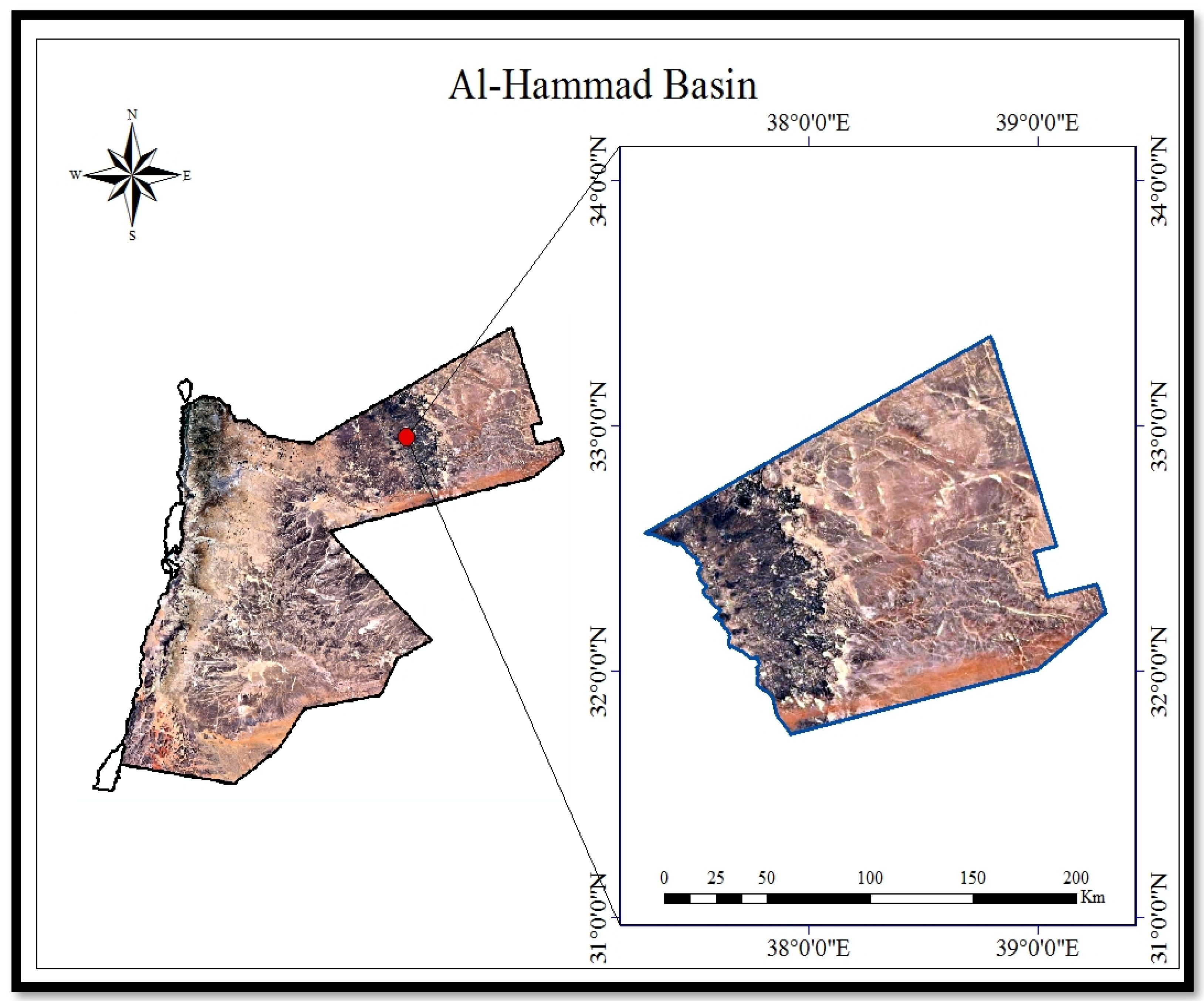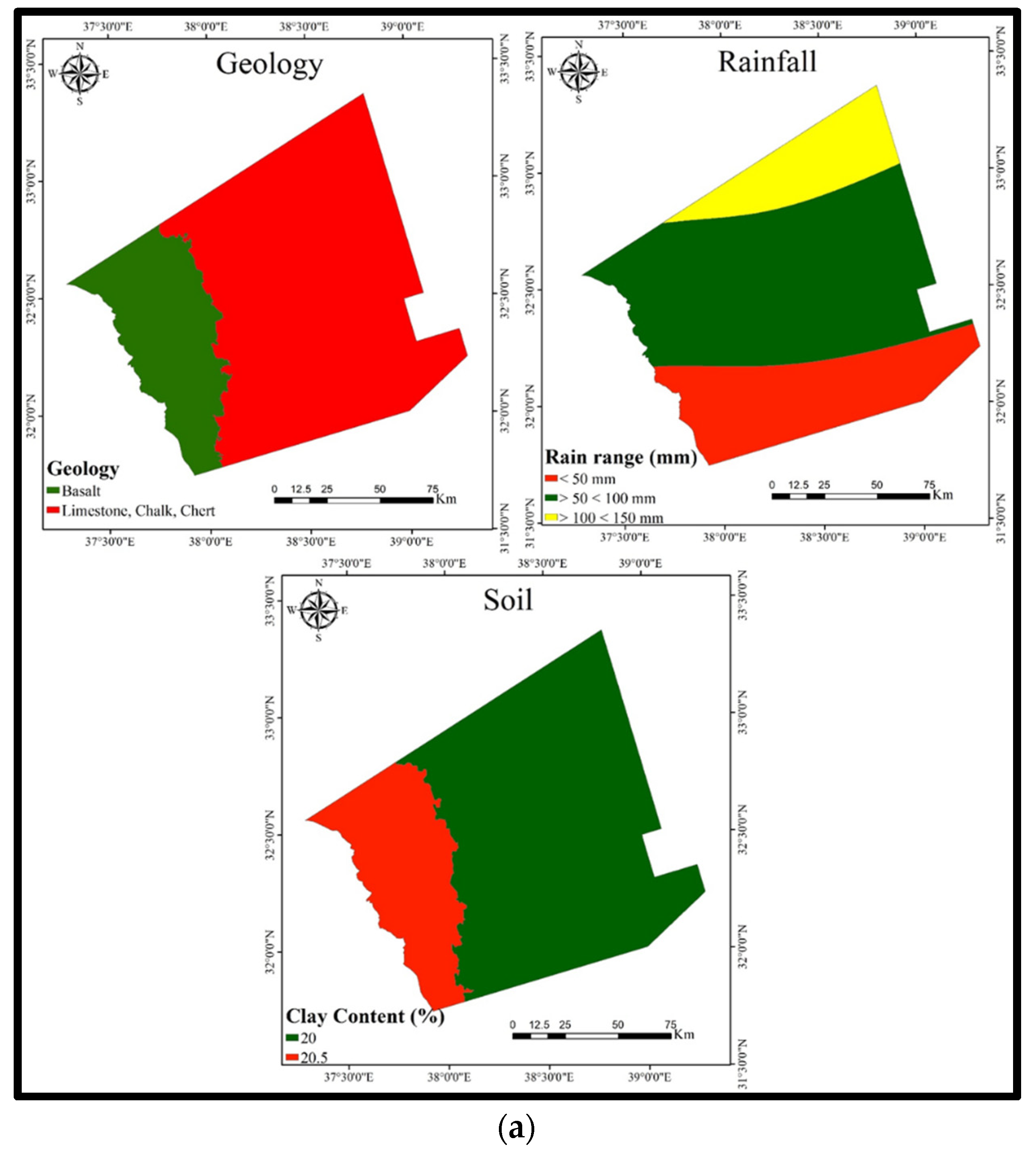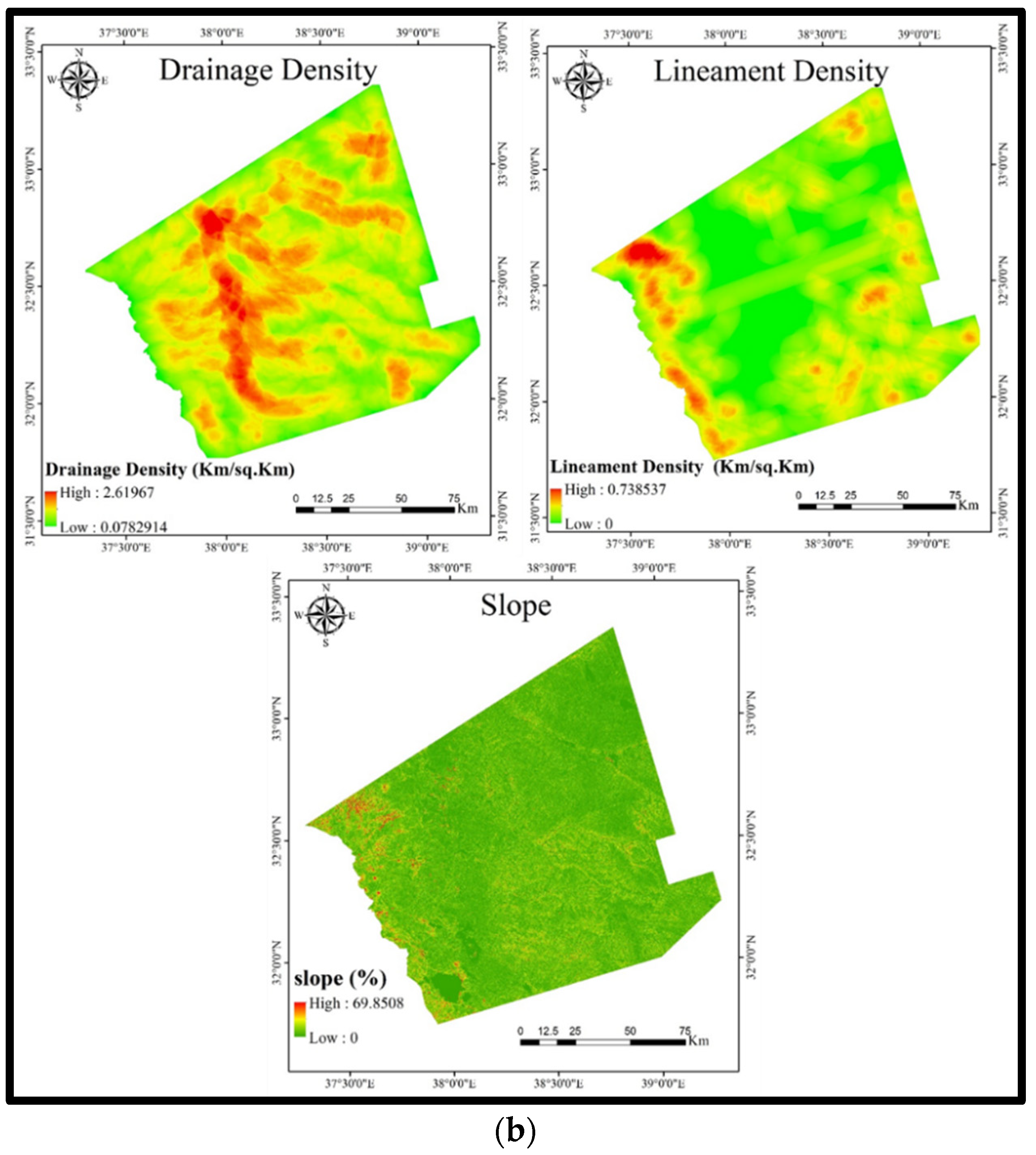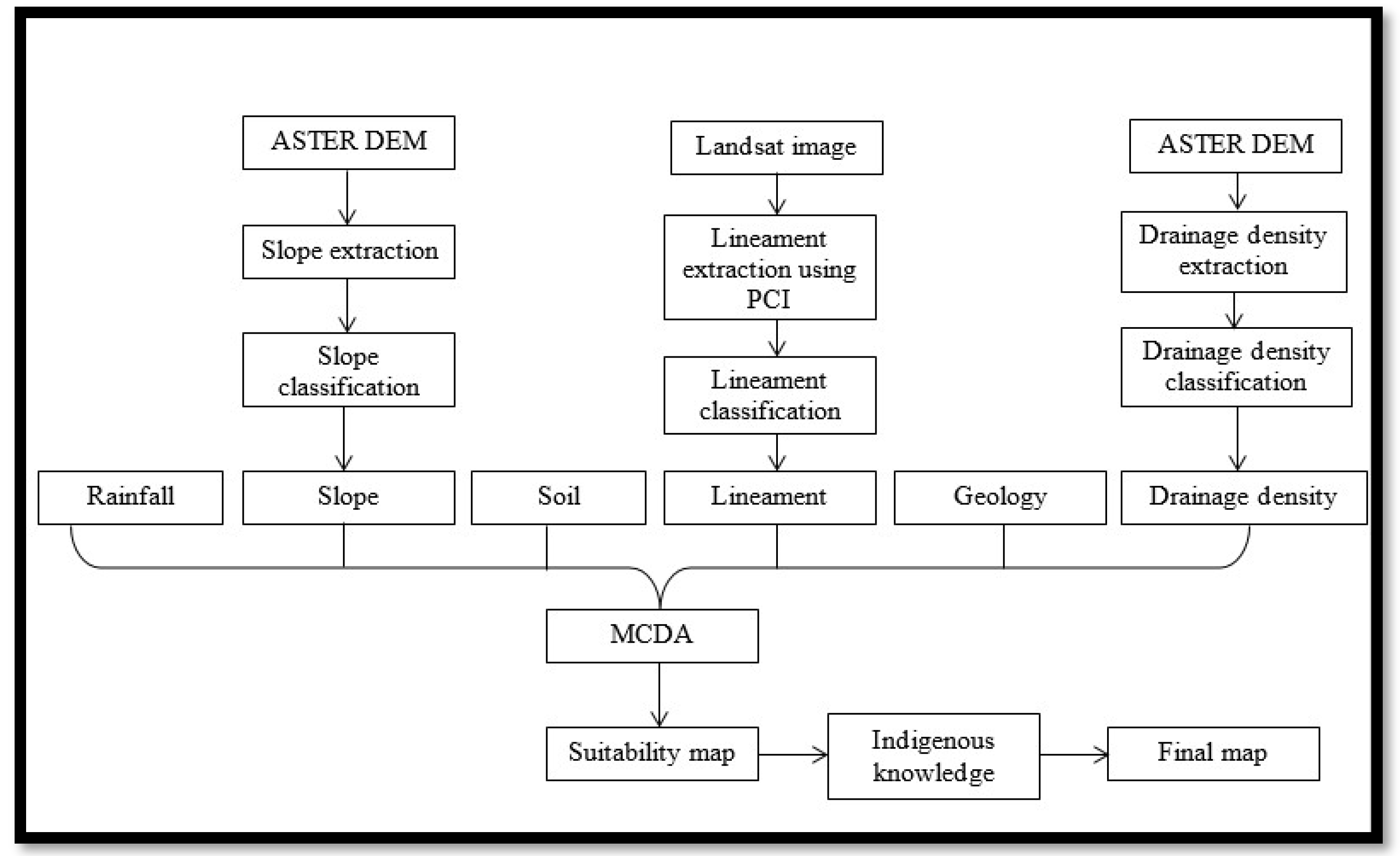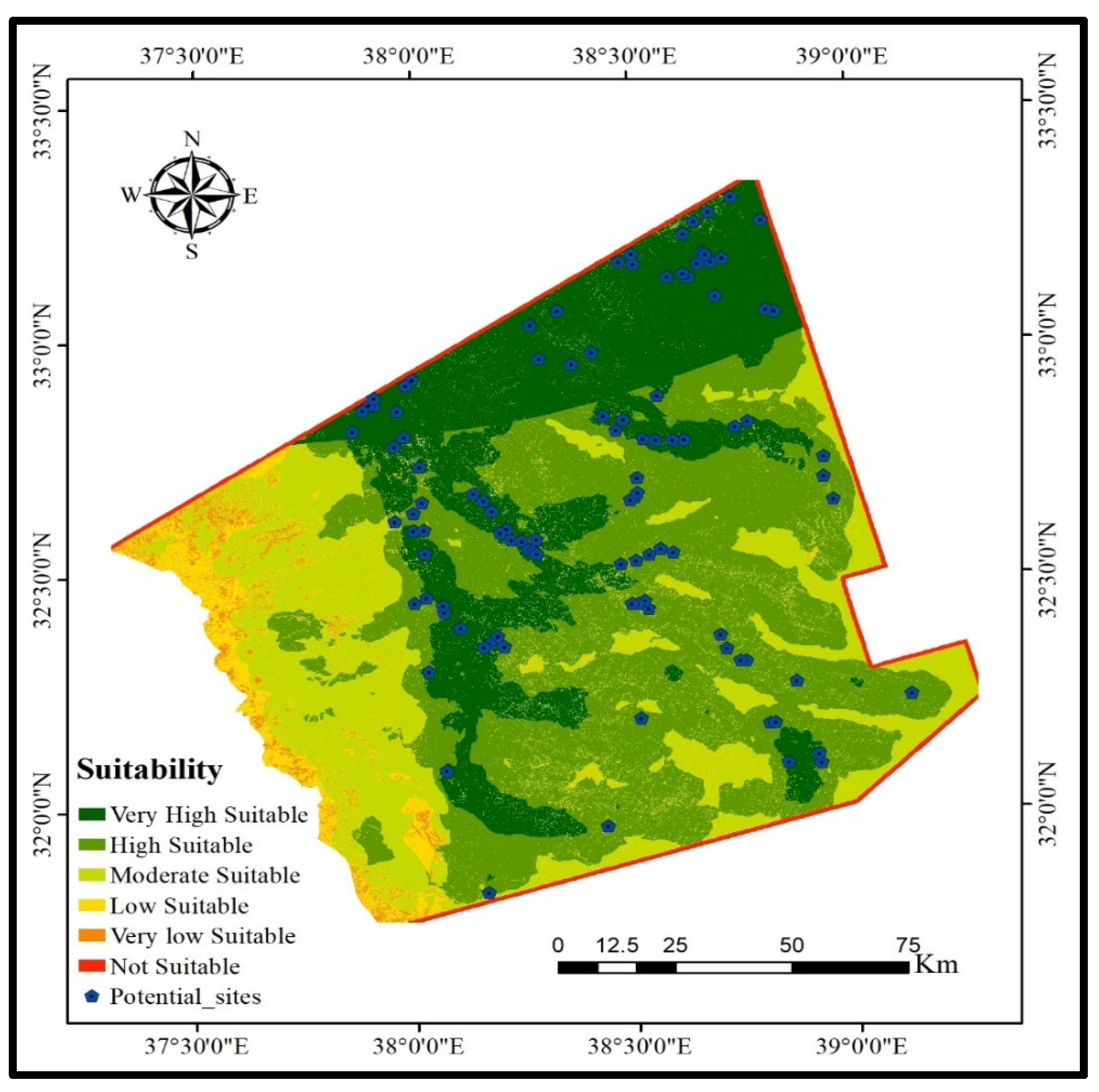1. Introduction
Water has a critical role to play in the socio-economic development of communities. It is a scarce resource in Jordan, which is classified as a semi-arid region. In fact, Jordan is categorized as one of the four poorest countries in water resources in the World. On average, the Jordanian individual consumes less than 100 m
3 of water in the year [
1,
2], which is much lower than the global individual’s average water consumption rate of approximately 1000 m
3/year. The individual low water consumption rate in Jordan is ascribed to the aridity of the country and the high population growth rate due to the high birth rate and flow of refugees into the country (Syrians, Palestinians, and Iraqis) [
3]. This forced high pressure on the water resources in Jordan, which are quite limited and cannot keep up with the ever-growing demand for water in the country [
4]. The scarcity of fresh water in Jordan is a critical constraint to the growth and development of the country. Because of this, effective harvesting of water, whenever possible, is vital for Jordan to minimize rainwater loss and maximize water storage [
5].
Rainwater harvesting is simply collecting, accumulating, and storing rainwater. Harvesting rainwater is commonly practiced to provide water for drinking, irrigation, livestock use, and groundwater recharge. Traditionally, several water-harvesting methods have been applied over centuries. One of the earliest methods in the Middle East was founded on the diversion of wadi (i.e., valley) flows through dry streams to agricultural lands.
Water harvesting is particularly fitting for the arid and semi-arid areas in the world, where the rainfall volume is either inadequate for sustaining good pasture and crop growth or the crop failure risk is very high because of irregular or intermittent precipitation. Water harvesting contributes to increased plant growth and, hence, production in areas subject to drought through the provision of an additional source of water for irrigation via directing the rainfall runoff through carefully selected routes within the target area and concentrating it in certain parts of it to be available in reasonable quantities for human use [
6]. In this context, harvesting water has been a common practice throughout history in Jordan for household and irrigation goals.
A Multi-Criteria Decision Analysis (MCDA) was employed in the Geographic Information System (GIS) environment by researchers for the selection of the optimum locations for water harvesting (e.g., Elewa et al. [
7], Al-Khuzaie et al. [
8], Sayl et al. [
9], Srivalli and Singh [
10], Adham et al. [
11], Al-Adamat et al. [
12,
13], Al-shabeeb [
14], Bakir and Xingnan [
15], and Gupta et al. [
16]). In most of these studies, the variables used to identify the sites with high potential for water harvesting were rainfall volume, slope, soil texture, site geology, drainage density, and lineament density. The viability of integrating indigenous knowledge with geoinformatics to determine the most suitable sites for water harvesting has been investigated by several researchers, including Elewa et al. [
7], Al-shabeeb [
14], Al-Adamat et al. [
12], Izugbara et al. [
17], Oweis et al. [
18], Eastman [
19], Vorhauer and Hamlett [
20], and Gonzalez [
21]).
For the analysis of data in an effort to locate the optimum locations for water harvesting, this study followed the approach to data analysis that was used by Elewa et al. [
7], Al-shabeeb [
14], Smerdon et al. [
22], and Gonzalez [
21]. All variables under consideration were assigned equal weights and binary coding in which 1 denotes a suitable site for water harvesting and 0 points to a non-suitable site. This approach differs from the approach followed by Shatnawi [
23], Al-shabeeb [
14], and Al-Adamat et al. [
12], who employed the Weighted Linear Combination (WLC) method owing to the fact that weighting is a highly sophisticated process, and it may produce misleading outcomes. Al-Adamat et al. [
12] pinpointed that interpreting weights as a general indicator of importance is misleading. The incorrect allocation of weights is a particularly popular error in applying the WLC method to spatial problems [
12,
14].
The principal aim of this work was to develop criteria for selecting the best locations for rainwater harvesting in the Wadi Hammad basin in Jordan by incorporating indigenous knowledge with MCDA in the GIS environment. The strategic national plans for investment in the agricultural sector aim to improve the living conditions of citizens and workers in the agricultural sector, increase agricultural production, and increase the use of modern technology to improve water use efficiency. However, investment in the agricultural sector in Jordan suffers from several challenges, which mainly include climate change, the lack of sufficient water resources in Jordan, both groundwater and surface water, and the limited sources of funding to support agricultural organizations and associations. One of the current priorities of the government is investing in the agricultural sector in the Wadi Hammad basin, east of Jordan, to attract investors and investments to this sector and area and provide the necessary facilities for creating job opportunities for local communities and support the national economy.
The primary goal of this study was to integrate indigenous knowledge with MCDA in the GIS environment, ultimately to identify potential locations for efficient water harvesting in the Wadi Hammad basin in Jordan, one of the promising basins in Jordan. Despite the scarcity of water in this basin and the very low rainfall amount (it receives 50–150 mm of rainfall in a year), the precipitation regime in this basin is distinguished by intense rainfall of a short duration. This suggests that this basin is a good location for water-harvesting projects.
4. Conclusions and Recommendations
Integrating indigenous knowledge of the local community with MCDA in the GIS environment helps decision makers in making the right decisions. The importance of utilizing local knowledge when selecting the most appropriate sites for water harvesting lies in the fact that this knowledge supports the decision-making process. Local knowledge is based on experience with the nature of the area of interest. Different types of rainwater-harvesting practices—such as Hafirs (small ponds) and pools for water-harvesting techniques—have long been available in the study area as they are traditional methods. This contributes to determining the possibility for it to be exploited for water-harvesting purposes. This study identified potential locations within the study area that can be exploited for water-harvesting purposes based on the knowledge of local people of the area as livestock owners. It verifies the outcomes of the various GIS analyses for determining whether the sites under investigation will be compatible with local knowledge or not. Based on a review of the literature, six criteria were selected to identify the optimal locations for water harvesting in the Wadi Hammad basin (rainfall, soil clay content, slope, lineament density, drainage density, and geology). Then, a Multi-Criterion Decision Analysis (MCDA) was employed to determine the sites within this basin with high potential for water harvesting. The approach of this study was based on integrating all criteria after the multiplication of each with its relative importance rating, specifying the weights of criteria, and unifying the rating for every criterion. The study classified site suitability for water harvesting into six classes: Lacking suitability, very low suitability, low suitability, moderate suitability, high suitability, and very high suitability. More than 40 locations have been found to be highly suitable for water harvesting based on recommendations of the local community and MCDA analysis. In view of the statistical tests performed on the water-harvesting criteria, this study found that lineament density, rainfall, drainage density, soil clay content, geology, and slope have the highest importance in the determination of the best locations for water harvesting. This study contributes to integrating indigenous knowledge with MCDA in the GIS environment to specify the site potential for water harvesting in the Wadi Hammad basin and augment the water resources in the study area if the identified sites are utilized for water harvesting. Doing so will contribute much to sustainable socio-economic development in Jordan. In light of these findings, this study recommends the inclusion of local communities in the specification and selection of the water-harvesting sites. As a matter of fact, the successful selection of suitable sited for water harvesting depends on the relationship between indigenous knowledge and the outcomes of MCDA.
